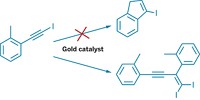Advertisement
Grab your lab coat. Let's get started
Welcome!
Welcome!
Create an account below to get 6 C&EN articles per month, receive newsletters and more - all free.
It seems this is your first time logging in online. Please enter the following information to continue.
As an ACS member you automatically get access to this site. All we need is few more details to create your reading experience.
Not you? Sign in with a different account.
Not you? Sign in with a different account.
ERROR 1
ERROR 1
ERROR 2
ERROR 2
ERROR 2
ERROR 2
ERROR 2
Password and Confirm password must match.
If you have an ACS member number, please enter it here so we can link this account to your membership. (optional)
ERROR 2
ACS values your privacy. By submitting your information, you are gaining access to C&EN and subscribing to our weekly newsletter. We use the information you provide to make your reading experience better, and we will never sell your data to third party members.
Synthesis
Copper-Templated Coupling
December 17, 2007
| A version of this story appeared in
Volume 85, Issue 51
In 2000, Jiri Srogl and Lanny S. Liebeskind of Emory University reported a unique coupling of thiol esters with boronic acids to produce ketones. That reaction, mediated by a palladium catalyst and a stoichiometric copper cocatalyst, operates at neutral pH and in the absence of oxygen to protect sensitive functional groups. Srogl, Liebeskind, and Janette M. Villalobos have now determined that the same reaction can be carried out under aerobic conditions without a palladium catalyst (J. Am. Chem. Soc., DOI: 10.1021/ja074931n). The key is formation of a Cu(I)-thiol ester complex, which is oxidized by O2 in the air to form a Cu(II/III) intermediate. This intermediate serves as a template for the thiol ester-boronic acid coupling to form a ketone. The residual copper thiolate complex reacts with a second equivalent of boronic acid to form a thioether, a process that regenerates the starting Cu(I) complex and completes the catalytic cycle. So far, the Emory team has synthesized peptidyl ketones, in addition to the reported 1:1 mixtures of ketones and thioethers.





Join the conversation
Contact the reporter
Submit a Letter to the Editor for publication
Engage with us on Twitter